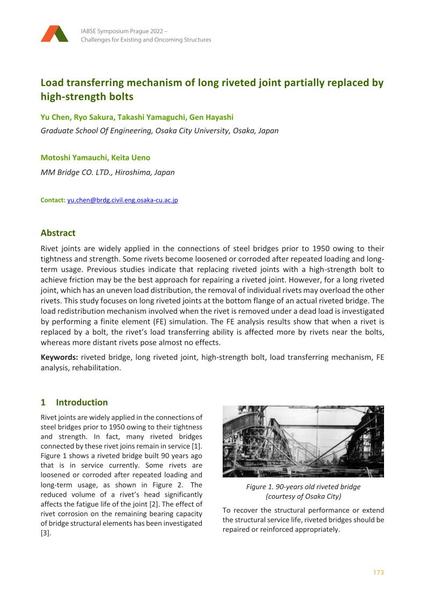Load transferring mechanism of long riveted joint partially replaced by high-strength bolts

|
|
|||||||||||
Détails bibliographiques
| Auteur(s): |
Yu Chen
(Graduate School Of Engineering, Osaka City University, Osaka, Japan)
Ryo Sakura (Graduate School Of Engineering, Osaka City University, Osaka, Japan) Takashi Yamaguchi (Graduate School Of Engineering, Osaka City University, Osaka, Japan) Gen Hayashi (Graduate School Of Engineering, Osaka City University, Osaka, Japan) Motoshi Yamauchi (MM Bridge CO. LTD., Hiroshima, Japan) Keita Ueno (MM Bridge CO. LTD., Hiroshima, Japan) |
||||
|---|---|---|---|---|---|
| Médium: | papier de conférence | ||||
| Langue(s): | anglais | ||||
| Conférence: | IABSE Symposium: Challenges for Existing and Oncoming Structures, Prague, Czech Republic, 25-27 May 2022 | ||||
| Publié dans: | IABSE Symposium Prague 2022 | ||||
|
|||||
| Page(s): | 173-180 | ||||
| Nombre total de pages (du PDF): | 8 | ||||
| DOI: | 10.2749/prague.2022.0173 | ||||
| Abstrait: |
Rivet joints are widely applied in the connections of steel bridges prior to 1950 owing to their tightness and strength. Some rivets become loosened or corroded after repeated loading and long- term usage. Previous studies indicate that replacing riveted joints with a high-strength bolt to achieve friction may be the best approach for repairing a riveted joint. However, for a long riveted joint, which has an uneven load distribution, the removal of individual rivets may overload the other rivets. This study focuses on long riveted joints at the bottom flange of an actual riveted bridge. The load redistribution mechanism involved when the rivet is removed under a dead load is investigated by performing a finite element (FE) simulation. The FE analysis results show that when a rivet is replaced by a bolt, the rivet’s load transferring ability is affected more by rivets near the bolts, whereas more distant rivets pose almost no effects. |
||||
| Copyright: | © 2022 International Association for Bridge and Structural Engineering (IABSE) | ||||
| License: | Cette oeuvre ne peut être utilisée sans la permission de l'auteur ou détenteur des droits. |
||||
